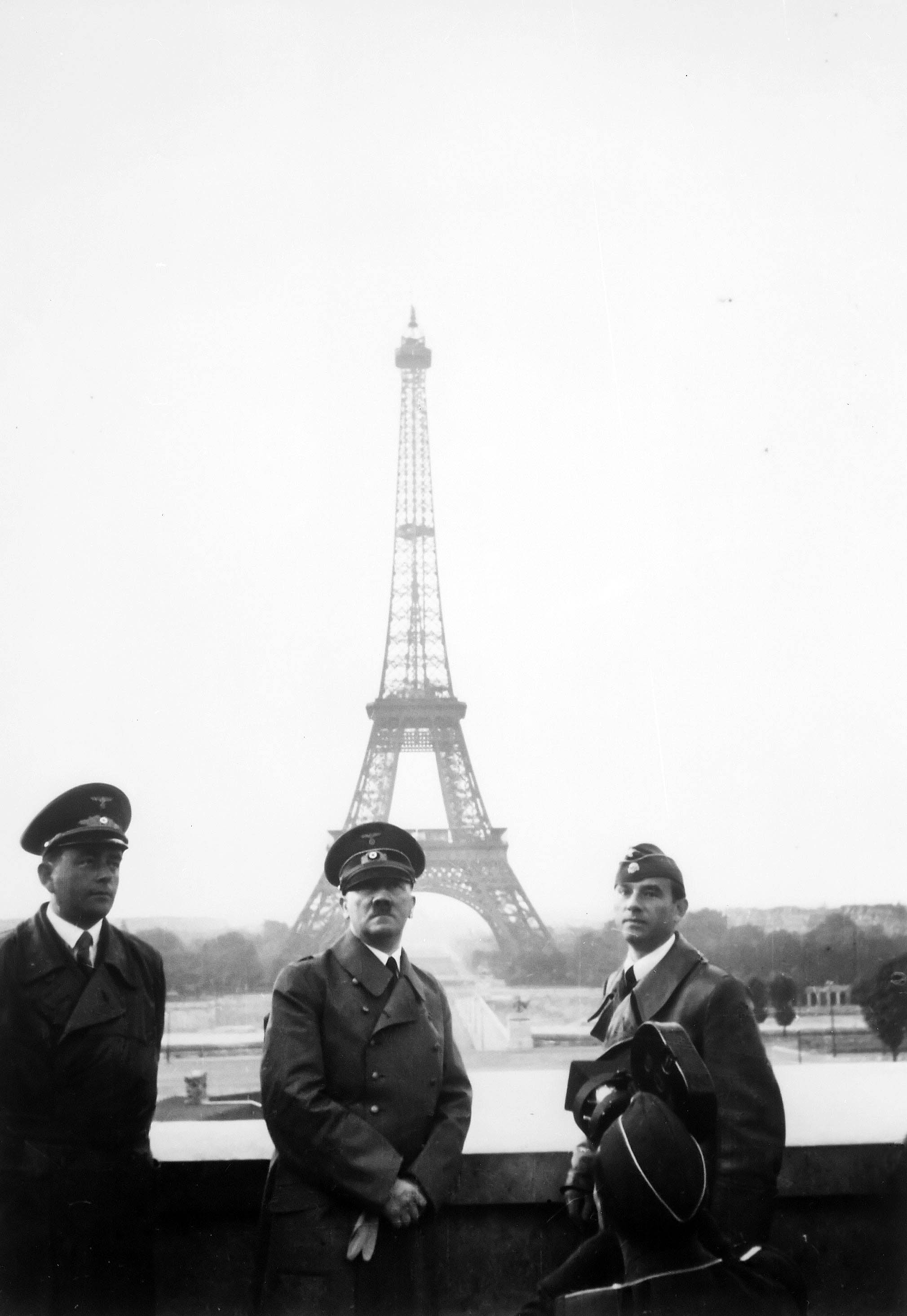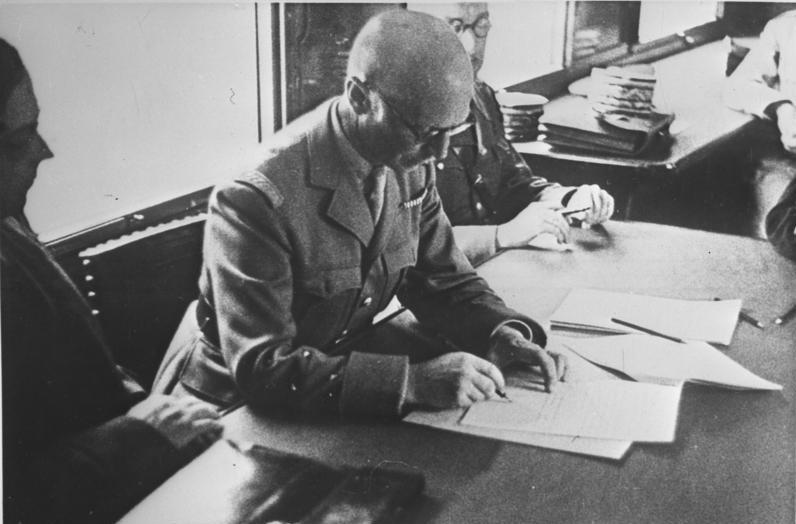On 11 November 1918, the French and British allies accepted Germany’s surrender and, between them, signed the armistice that ended the First World War. The signing took place in a railway carriage in the middle of the picturesque woods of Compiègne, fifty miles north-east of Paris. The humiliation of that event ran deep into the psyche of Germany, and none more so than in Adolf Hitler, at the time a corporal in the Imperial German Army.
 On 22 June 1940, Hitler, now the German Führer, got his revenge – it was the turn of the French to surrender, and Hitler made sure that it was done in the most demeaning circumstances possible – in exactly the same carriage and in the same spot as the signing twenty-two years earlier.
On 22 June 1940, Hitler, now the German Führer, got his revenge – it was the turn of the French to surrender, and Hitler made sure that it was done in the most demeaning circumstances possible – in exactly the same carriage and in the same spot as the signing twenty-two years earlier.
The Fall of France
Following the 1914-1918 war, the French had built a defensive 280-mile long fortification, the Maginot Line, all along the Franco-German border as protection against a future German attack. The Battle of France began on 10 May 1940. The Germans rendered the Maginot Line obsolete within a morning by merely skirting around the north of it, through the Ardennes forest. Because of its rugged terrain, the French considered the forest impassable. Reaching the town of Sedan on the French side of the Ardennes on 14 May and brushing aside French resistance, the Germans pushed forward, not towards Paris as expected, but north, towards the English Channel, forcing the French and their British allies further and further back. In 1916, the Germans had failed to take Verdun despite ten months of trench warfare; in May 1940, it took them but a day.
Elsewhere, Hitler’s armies were enjoying victory after victory – the Netherlands capitulated on 15 May, followed two weeks later by the surrender of Belgium. Allied forces, with their backs to the sea in the French coastal town of Dunkirk, were trapped. But the Germans, poised to annihilate the whole British Expeditionary Force, were inexplicably ordered by Hitler to halt outside the town. Between 26 May and 2 June, over 1,000 military and civilian vessels were rescued and brought back to Britain 338,226 Allied soldiers. But not without scenes of panic, broken discipline and soldiers shot by their officers for losing self-control. Meanwhile, Hitler’s generals watched, puzzled and rueing an opportunity missed.
Winston Churchill may have viewed Dunkirk as a ‘deliverance’ but the French considered the British cowards for what they saw as a betrayal at Dunkirk. Hitler too thought little of the British soldier: ‘They can certainly beat their colonial subjects with a whip but on the battlefield, they are miserable cowards’.
The Swastika flies over Paris
The fall of France was dramatic in its speed. German Chief of General Staff, Franz Halder, who had organised the invasion of Poland eight months earlier, warned Hitler of the folly of attacking France. Privately, he believed it to be ‘idiotic and reckless’. In the event, Hitler’s forces entered a largely deserted Paris on 14 June, over two million Parisians having fled south. Soon the swastika flag was flying from the Arc de Triomphe.
On 16 June, the French general, Charles de Gaulle, escaped France to begin his life of exile in London. He was later sentenced to death – in absentia by the French Vichy government.
In Britain, Winston Churchill, appointed prime minister only on 10 May, urged the French to keep on fighting and discussed the possibility of France and Great Britain becoming one unified nation. When French prime minister, Paul Reynaud, put the idea of the union to the French government, now based in Bordeaux, the idea was ridiculed. Marshal Philippe Petain, hero of the 1916 Battle of Verdun, preferred to surrender – to continue the fight would destroy the country and a union with Britain would be akin to a ‘marriage with a corpse’. French general, Maxime Weygand, believed that following the fall of France, the British would soon have ‘its neck wrung like a chicken’ by the Germans.
On 17 June, Reynaud resigned, to be replaced by the 84-year-old Petain, whose first acts were to seek an armistice with the Germans and order Reynaud’s arrest. France had been defeated.
The Forest of Compiègne
On 20 June the Germans had prepared the text for the French-German armistice, with Hitler dictating its preamble. The venue for the signing was to be the forest of Compiègne, where, 22 years before, at the end of the First World War, the Germans had surrendered to the French and signed the armistice of 11 November 1918. Hitler, with a flair for the dramatic, ordered that the signing ceremony should take place in the very same railway carriage that had been used in November 1918, now on display in a Parisian museum. The carriage, once a dining car, which had been transformed into a conference room, split into two by a glass partition, was transported north.
 About 200 yards from the carriage stood the Alsace-Lorraine statue (pictured), commemorating the 1918 signing, featuring a fallen German eagle, impaled by the sword of the victorious allies. Now, in June 1940, it was adorned by the Nazi swastika. Nearby, a statue of Marshal Ferdinand Foch, the French commander-in-chief, who had led the negotiations in 1918.
About 200 yards from the carriage stood the Alsace-Lorraine statue (pictured), commemorating the 1918 signing, featuring a fallen German eagle, impaled by the sword of the victorious allies. Now, in June 1940, it was adorned by the Nazi swastika. Nearby, a statue of Marshal Ferdinand Foch, the French commander-in-chief, who had led the negotiations in 1918.
At 3.15 on the afternoon of 21 June, a warm summer’s day, the German delegation arrived and emerged from their Mercedes: Hermann Goering, Rudolph Hess, Joachim von Ribbentrop, Wilhelm Keitel, Erich Raeder, Alfred Jodl amongst others and, last of all, Hitler, his First World War Iron Cross pinned upon his tunic.
The American journalist and writer, William Shirer, author of the excellent, Rise and Fall of the Third Reich, originally published 1959, was a witness to the occasion. Shirer describes the expression on Hitler’s face: ‘grave, solemn, yet brimming with revenge… There was something else, difficult to describe, in his expression, a sort of scornful, inner joy at being present at this great reversal he himself had wrought.’
Hitler and his entourage stopped to read the French inscription of a granite block, which read in capitals, ‘HERE ON THE ELEVENTH OF NOVEMBER 1918 SUCCUMBED THE CRIMINAL PRIDE OF THE GERMAN EMPIRE – VANQUISHED BY THE FREE PEOPLES WHICH IT TRIED TO ENSLAVE.’
The German delegation took their place in the carriage, Hitler pointedly sitting where Foch had sat 22 years before. Then arrived the French delegation, headed by General Charles Huntziger. Shirer noticed that the German guard of honour, ‘snapped to attention for the French as they passed but did not present arms’.
With everyone sitting, Keitel, with a monocle in his eye, read aloud Hitler’s preamble of the armistice, a translator relaying it to the French. At the glass partition, one of Hitler’s henchman, Otto Günsche (who took on the responsibility of burning Hitler’s body following his leader’s suicide on 30 April 1945), kept guard with orders to shoot anyone who ‘should dare to conduct himself in an improper manner towards Hitler’.
Hitler uttered not a word. With the reading of the preamble done, Hitler and most of his entourage made their exit with a Nazi salute, and left to the sound of the German national anthem and the Horst Wessel song (a Nazi favourite composed in memory of a Nazi ‘martyr’) ringing in their ears. The French delegates stood, some with tears in their eyes.
The French sign the Armistice
 Keitel and Jodl stayed behind to discuss the details of the armistice with Huntziger (pictured). France was to be split into two – the northern half occupied by the Germans and the southern half run by a French government answerable to the Germans. This government, headed by Petain, was to be based in the spa town of Vichy.
Keitel and Jodl stayed behind to discuss the details of the armistice with Huntziger (pictured). France was to be split into two – the northern half occupied by the Germans and the southern half run by a French government answerable to the Germans. This government, headed by Petain, was to be based in the spa town of Vichy.
At 18:30, the following day, with the Germans getting impatient, the French were given one hour to sign or face a resumption of hostilities. Huntziger, speaking to General Weygand in Bordeaux, insisted that he should be ordered to sign the armistice and not merely authorized to sign it, thereby removing the responsibility from his shoulders. At 18:50, Huntziger and Keitel duly signed the hateful document.
On hearing the news, Hitler was delighted. Exactly one year later, he would launch the German invasion of the Soviet Union.
Straight afterwards, on Hitler’s orders, the railway carriage and the monument commemorating the 1918 signing were destroyed. The following day, Hitler visited Paris, his only visit, for a whistle-stop tour of sightseeing. On visiting Napoleon’s tomb, he said: ‘That was the greatest and finest moment of my life’. Before departing, he ordered the demolition of two Parisian First World War monuments, including the monument to Edith Cavell, the British nurse shot by the Germans in Brussels in October 1915.
The German occupation of France would last four long years until, in August 1944, two months after the start of the Normandy landings, France was finally liberated.
 Rupert Colley.
Rupert Colley.
Read more about the war in The Clever Teens Guide to World War Two available as an ebook and 80-page paperback from Amazon, Barnes & Noble, Waterstone’s, Apple Books and other stores.
Good condensed article with references to WWI.